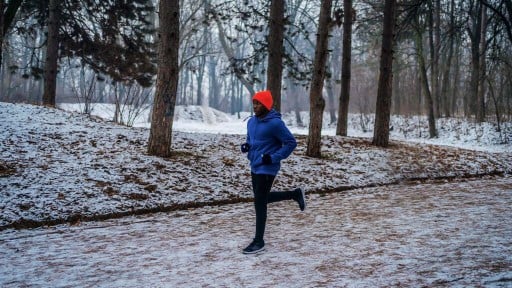Winter fitness: Extra benefits you get running in colder weather

- Experts say running in cold weather provides boosts over warm weather running due to a number of factors, including exertion, metabolic strain, and calorie-burning brown fat.
- They note that exercising during the winter is also a way to combat seasonal affective disorder.
- Experts recommend proper layering for cold weather, along with more grippy footwear if conditions are slippery.
- They add that new runners should consult with their doctor, then slowly build toward their goals.
Running can be an effective workout for cardiovascular fitness all year round.
However, recent research concludes that going for a run in colder temperatures can provide an extra boost.
Experts interviewed by Medical News Today say that while winter runs might necessitate some extra precautions in terms of attire and footwear, these chilly workouts provide benefits that summer exercise simply doesn’t have.
“Running is a good cardiovascular exercise. You’re using just about every leg muscle as well as swinging the arms, so while it isn’t necessarily a total body workout, it’s pretty close,” Dr. Joshua Blomgren, a Chicago-based primary care sports medicine specialist at Midwest Orthopaedics at RUSH as well as an aid station medical captain for the Chicago Marathon, told Medical News Today.
“You’re going to get those cardiovascular benefits from running in hot or cold weather, but what the body goes through to maintain body temperature in cold weather running is a little bit different,” he added.
What happens when you warm up in cold weather
Blomgren points to a number of recent studies that tout the benefits of cold weather running along with the challenges of hot weather running.
A benefit of colder runs is the mental and emotional boost – or “runner’s high” – that helps mitigate the effects of seasonal affective disorder (SAD) during the winter months.
One intriguing factor in cold weather running is thermogenesis, which is the process through which the body produces and maintains heat in cold temperatures.
“The body goes through a different process in terms of maintaining heat in the cold, which generally is relying on something called brown fat, which helps to burn calories,” Blomgren explained. “In response to the cold, the body will generate more brown fat, which is better than white fat at maintaining or generating heat.”
“In warm temperatures, we have sweating as a cooling mechanism, and that takes blood from the central body to the extremities,” Zaslow told Medical News Today. “But in cooler weather, you don’t need to be sending that blood volume to the skin and extremities as much, so you have a larger blood volume available. This would enable you to run at about the same running pace, but with a lower heart rate.”
Preparation is key to running in cold weather
For a runner who typically works out during milder weather or indoors on a treadmill, there isn’t a lot to keep track of in terms of clothing and equipment: typically comfortable clothing along with a good pair of running shoes.
However, for those who want to brave the cold weather and get the added cardiovascular boost that comes with winter running, experts say it’s even more important to warm up properly and consider proper clothing options.
Zaslow says that cold weather tends to make the body feel stiff and tight, so it’s a good idea to do a dynamic warmup before a run. From there, it’s important to layer properly.
“Layering clothing is really important because you’ll be cold in the beginning and then as your body warms up, you’ll want to be able to peel off those layers,” she said. “Some recommendations say to dress for about 15 to 20 degrees warmer than the actual temperature because you’ll warm up by about that much during the run.”
Even though sweat isn’t generally as much of a factor in cold weather, it’s still a factor – so Zaslow recommends wearing not just layers but also moisture wicking materials that transfer sweat away from the body.
“If you wear something like cotton or wool, it gets wet, it gets close to your body, and it cools you off, which is great in hot temperatures but not so great in the cold,” she said.
Footwear is perhaps the most important piece of equipment for runners. Regular running shoes are fine in the cold if snow and ice aren’t a factor, but they likely won’t cut it in more slippery conditions.
For temperatures that are below freezing or anytime there’s ice on the ground, Zaslow recommends a more grippy running shoe or even a traction device such as crampons that can be attached to the shoes.
Both Zaslow and Blomgren point out that the extremities – fingers, toes, ears, and nose – are areas to be mindful of, as they can get very cold if left uncovered.
“Breathing in the cold air can be a little bit harsh on the lungs and can induce almost an asthmatic state, so I usually recommend people wear some type of coverage over their nose or mouth to pre-warm the air before it goes into the lungs,” said Blomgren.
If you’re just starting out
If a subzero jogging sounds too daunting, it’s good to remember that a run in more temperate conditions or even indoors, still carries many benefits when it comes to overall health.
Blomgren says it’s a good idea for new runners to talk with their physician about their goals, particularly if they have underlying health issues such as high blood pressure, heart disease, or high cholesterol.
From there, it’s a good idea to build slowly and avoid taxing the body too much too soon.
“There are great resources within the running community for anyone who’s starting a running program,” he said. “The one that we usually reference is called a couch-to-5K program, which builds over six or eight weeks to being able to run 3.1 miles.”
While experienced runners might be looking to boost their experience by training in the cold, the study findings provide a reminder of how important it is to get any kind of physical activity during the winter months.
“I think running is great and you shouldn’t be afraid,” said Zaslow. “Winter is known for seasonal affective disorder where the days are shorter, there’s less sunlight, and people just tend to have a lower mood. Just getting outside as much as possible tends to really promote the feel-good chemicals of endorphins and serotonin, so it’s good to promote exercise of any type during the winter months, whether it’s running or walking.”








